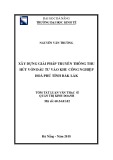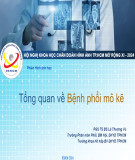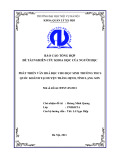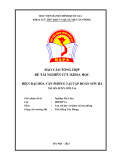
Open Access
Available online http://ccforum.com/content/10/2/R51
Page 1 of 9
(page number not for citation purposes)
Vol 10 No 2
Research
Decompressive laparotomy for abdominal compartment
syndrome – a critical analysis
Jan J De Waele1, Eric AJ Hoste1 and Manu LNG Malbrain2
1Intensive Care Unit, Ghent University Hospital, Gent, Belgium
2Intensive Care Unit, Campus Stuivenberg, ZiekenhuisNetwerk Antwerpen, Antwerp, Belgium
Corresponding author: Jan J De Waele, jan.dewaele@Ugent.be
Received: 20 Jul 2005 Revisions requested: 24 Aug 2005 Revisions received: 20 Feb 2006 Accepted: 27 Feb 2006 Published: 27 Mar 2006
Critical Care 2006, 10:R51 (doi:10.1186/cc4870)
This article is online at: http://ccforum.com/content/10/2/R51
© 2006 De Waele et al.; licensee BioMed Central Ltd.
This is an open access article distributed under the terms of the Creative Commons Attribution License (http://creativecommons.org/licenses/by/2.0),
which permits unrestricted use, distribution, and reproduction in any medium, provided the original work is properly cited.
Abstract
Introduction Abdominal compartment syndrome (ACS) is
increasingly recognized in critically ill patients, and the
deleterious effects of increased intraabdominal pressure (IAP)
are well documented. Surgical decompression through a
midline laparotomy or decompressive laparotomy remains the
sole definite therapy for ACS, but the effect of decompressive
laparotomy has not been studied in large patient series.
Methods We reviewed English literature from 1972 to 2004 for
studies reporting the effects of decompressive laparotomy in
patients with ACS. The effect of decompressive laparotomy on
IAP, patient outcome and physiology were analysed.
Results Eighteen studies including 250 patients who
underwent decompressive laparotomy could be included in the
analysis. IAP was significantly lower after decompression (15.5
mmHg versus 34.6 mmHg before, p < 0.001), but
intraabdominal hypertension persisted in the majority of the
patients. Mortality in the whole group was 49.2% (123/250).
The effect of decompressive laparotomy on organ function was
not uniform, and in some studies no effect on organ function was
found. Increased PaO2/FIO2 ratio (PaO2 = partial pressure of
oxygen in arterial blood, FiO2 = fraction of inspired oxygen) and
urinary output were the most pronounced effects of
decompressive laparotomy.
Conclusion The effects of decompressive laparotomy have
been poorly investigated, and only a small number of studies
report its effect on parameters of organ function. Although IAP
is consistently lower after decompression, mortality remains
considerable. Recuperation of organ dysfunction after
decompressive laparotomy for ACS is variable.
Introduction
Intraabdominal hypertension (IAH) is a clearly identified cause
of organ dysfunction in patients after emergency abdominal
surgery and trauma [1-3]. It is also increasingly recognized in
other patients in the intensive care unit (ICU), for example,
after elective surgical procedures [4], liver transplantation [5],
massive fluid resuscitation for extraabdominal trauma [6] and
severe burns [7]. The presence of IAH at admission to the ICU
has been associated with severe organ dysfunction during the
ICU stay, and the development of IAH during ICU stay was an
independent predictor of mortality [4].
The clinical picture resulting from sustained IAH has been
described as abdominal compartment syndrome (ACS).
Although understanding of the pathophysiology of IAH has
greatly improved [8,9], few advances have been made in the
treatment of ACS. Few non-surgical options are available for
the treatment of ACS. In some patients, IAH is caused by intra-
peritoneal fluid, and in these patients percutaneous drainage
may be an option, as has been described in patients with ACS
after burns [10]. The use of gastric and rectal tubes to drain air
and gastrointestinal contents has been proposed by experts,
but a scientific foundation is lacking [11]. Other proposed
therapies include ultrafiltration [12] and the use of muscular
blocking agents [13].
Surgical decompression is the only available definite treatment
for IAH, and numerous case series have been reported, but the
ACS = abdominal compartment syndrome; APACHE = Acute Physiology and Chronic Health Evaluation; CI=cardiac index; CVP = central venous
pressure; DL = decompressive laparotomy; DO2I = Oxygen delivery index; HR = heart rate; IAH = intraabdominal hypertension; IAP = intraabdominal
pressure; ICP = intracranial pressure; ICU = intensive care unit; ISS = Injury Severity score; MAP = mean arterial pressure; NA = not available; SOFA
= sepsis related organ failure assessment; SVRi = systemic vascular resistance index.

Critical Care Vol 10 No 2 De Waele et al.
Page 2 of 9
(page number not for citation purposes)
effects of surgical decompression have not been reviewed in
large series; patients who require decompression are fre-
quently a selected subpopulation of the total study population.
Also, most papers focus on factors associated with IAH and
its effects, rather than specifically looking at endpoints, such
as hospital mortality and organ function after surgical decom-
pression.
The goal of this review is to describe the effect of surgical
decompression through a midline laparotomy (termed 'decom-
pressive laparotomy' (DL) in this review) on intraabdominal
pressure (IAP) and the outcome and physiology of patients
undergoing this procedure.
Materials and methods
Relevant articles were identified through a computerized
search of the English literature using Web of Science version
7.2 (ISI Thomson, Philadelphia, USA) for the years 1972 to
2004. Search terms included 'intraabdominal hypertension'
OR 'abdominal compartment syndrome' and 'decompressive
laparotomy' OR 'decompression'. Review articles, case
reports and case series describing fewer than four patients
were excluded from the analysis.
Articles describing adult patients with IAH requiring decom-
pression were included in the analysis if: details on IAP – at
least before decompression – were available; and the out-
come was available for all patients who underwent abdominal
decompression. In this setting, DL was defined as a surgical
intervention on the abdominal wall aimed at reducing the IAP,
after which a temporary abdominal closure device was used;
percutaneous drainage of fluid collections or escharotomies
were not considered in this review.
The bibliographies of the articles that were included in the final
analysis were reviewed for relevant publications that would
have been missed by the computerized search.
For the articles retrieved, we classified the ACS according to
the current guidelines of the World Society of Abdominal
Compartment Syndrome [14] (Table 1), and recorded the indi-
cation for decompression. The effect of abdominal decom-
pression on organ function was recorded; hemodynamic
(blood pressure, heart rate, cardiac output, central venous
pressure, pulmonary occlusion pressure, systemic vascular
resistance and oxygen delivery indices), ventilatory (PaO2/
FIO2 ratio (PaO2 = partial pressure of oxygen in arterial blood,
FiO2 = fraction of inspired oxygen), peak airway pressure, lung
compliance expressed by static or dynamic compliance) and
renal function parameters (urinary output) were retrieved.
Patient characteristics such as age, disease severity as
expressed by the Acute Physiology and Chronic Health Evalu-
ation (APACHE) II score or Injury Severity score (ISS), and the
timing of DL after the precipitating event (hospital admission or
prior abdominal surgical intervention) were recorded when
available.
Statistical analysis was performed using SPSS for Windows
12.0® (SPSS, Chicago, IL, USA). IAP and physiological varia-
bles before and after DL were compared using paired samples
t test. Continuous data are expressed as mean (standard devi-
ation). A double sided p value of less than 0.05 was consid-
ered statistically significant.
Results
The computerized search yielded 85 papers, 19 of which
could be included in the analysis based on the analysis of the
type of article and review of the abstract. From the references
in these articles, another 8 papers were considered to contain
significant data, bringing the total number of studies reporting
on patients who underwent surgical decompression to 27.
After analysis of the data available in the papers, 9 papers
Table 1
Consensus definitions of intraabdominal hypertension, and
abdominal compartment syndrome (primary, secondary and
recurrent) according to WSACS
Term Definition
IAH IAH is defined by a sustained increase in IAP of
12 mmHg or more, recorded by a minimum of
three standardized measurements conducted 4
to 6 hours apart, with or without an APP <60
mmHg
ACS ACS is defined as a sustained increase in IAP of
20 mmHg or more with or without APP <60
AND single or multiple organ system failure that
was not previously present
Primary ACS ACS caused by:
A condition associated with injury or disease in
the abdomino-pelvic region that frequently
requires early surgical or angioradiological
intervention, OR
A condition that develops following abdominal
surgery (such as abdominal organ injuries that
require surgical repair or damage control
surgery, secondary peritonitis, bleeding pelvic
fractures or other cause of massive
retroperitoneal haematoma, liver transplantation)
Secondary ACS ACS caused by conditions that do not originate
from the abdomen (such as sepsis and capillary
leak, major burns, and other conditions requiring
massive fluid resuscitation), yet result in the
signs and symptoms commonly associated with
primary ACS
Recurrent ACS ACS caused by a condition in which it develops
following prophylactic or therapeutic surgical or
medical treatment of primary or secondary ACS
(e.g., persistence of ACS after DL or
development of a new ACS episode following
definitive closure of the abdominal wall after the
previous utilization of a temporary abdominal
wall closure)
ACS, abdominal compartment syndrome; APP, abdominal perfusion
pressure; DL, decompressive laparotomy; IAH, intraabdominal
hypertension; WSACS, World Society of Abdominal Compartment
Syndrome.

Available online http://ccforum.com/content/10/2/R51
Page 3 of 9
(page number not for citation purposes)
were excluded because of various reasons (no data on IAP
available (n = 5), no DL performed as a means of decompres-
sion (n = 1), analysis based on patients already described in
another paper that was included in the analysis (n = 1), indica-
tion for laparotomy planned for reasons other than ACS (n =
1), and insufficient data on the groups of patients that were
decompressed (n = 1).
The 18 papers included in the final analysis are in listed in
Table 2. In total, 250 patients were treated with DL for ACS,
of which 174 had primary ACS and 76 secondary ACS.
In four papers no indication for DL was named, but it could be
presumed it was ACS. No clear definition of ACS was men-
tioned in another five papers, and only six used a more or less
clear definition of ACS, including a cut off IAP level (Table 2).
The definitions of ACS were different in every paper, and most
noticeably the critical level of IAP that was considered an indi-
cation for DL varied from 18 to 30 mmHg. In one paper, uncon-
trollable intracranial pressure was the sole indication for DL
[15]. Mean interval from admission to the hospital or from the
previous surgical intervention to DL was reported only in a lim-
ited number of papers, and varied from 12 to 38 hours, except
from the study in which uncontrollable ICP was the indication
for DL; in this paper, the mean interval between admission and
DL was 139 hours.
Effect of surgical decompression on IAP
From 10 studies, IAP values before and after abdominal
decompression were available from a total of 161 patients; the
other studies only reported IAP values before decompression.
In all but one report [16], IAP fell significantly after surgical
decompression (Figure 1). Overall, the mean reported IAP
before DL was 34.6 mmHg (8.06) and fell to 15.5 mmHg
(4.81) after DL (p < 0.001).
Outcome after surgical decompression for ACS
Mortality rates for patients who underwent surgical decom-
pression for ACS are summarized in Table 3. Overall, reported
mortality for all patients with ACS who underwent surgical
Table 2
Overview of 18 papers included in the final analysis
Reference Journal Year No. of patients Indication for abdominal decompression Delay to
decompres
sion (hours)
Total Primary ACS Secondary ACS
[23] Ann Surg 1984 4 4 0 IAP >25 + acute renal failure NA
[25] Crit Care Med 1989 6 6 0 NA (presumably ACS) NA
[26] Aust NZ Surg 1990 10 10 0 IAP >18 + organ dysfunction NA
[27] S Afr Med J 1995 4 3 1 ACS 16
[17] Am J Surg 1997 21 21 0 ACS 27
[28] J Trauma 1998 11 11 0 IAP >25 mmHg + organ dysfunction 38
[18] J Trauma 1998 49 49 0 ACS 18
[29] J Trauma 1999 6 0 6 NA (presumably ACS) NA
[2] Crit Care Med 2000 17 13 4 ACS 13
[30] J Trauma 2000 6 0 6 NA (presumably ACS) NA
[31] Am J Surg 2001 28 28 0 IAP >20 + organ dysfunction 17
[32] Am J Surg 2001 10 0 10 ACS 12
[16] J Trauma 2002 4 0 4 ACS unresponsive to conservative measures NA
[10] J Burn Care Rehab 2002 4 0 4 IAP >30 + renal or ventilatory impairment 28
[33] Am Surg 2002 18 17 1 ACS NA
[34] Arch Surg 2003 9 0 9 NA (presumably ACS) 17
[35] J Trauma 2003 26 11 15 IAP >25 mmHg + progressive organ
dysfunction
13
[15] J Trauma 2004 17 1 16 Uncontrollable ICP 139
Total 250 174 76
ACS, abdominal compartment syndrome; IAP, intraabdominal pressure; ICP, intracranial pressure; NA, not available.

Critical Care Vol 10 No 2 De Waele et al.
Page 4 of 9
(page number not for citation purposes)
decompression was 49.2% (123/250). The mean age in the
different studies was 44.5 years. The severity of disease, as
assessed by APACHE II score and ISS, is generally high in
these patients, but was not available in most of the papers; an
APACHE II-based predicted mortality, therefore, could not be
calculated for these patients.
The cause of death of patients who underwent DL could be
retrieved from only nine of the studies. This accounted for only
29 out of the total of 123 patients who died. The main cause
of death after DL was single or multiple organ dysfunction (n
= 23, 79%); other causes included head injury (n = 2, 7%)
and haemorrhage (n = 1, 3%). In three patients, therapy was
withdrawn.
Effect of abdominal decompression on hemodynamic,
respiratory and renal function parameters
Table 4 summarizes the effect of abdominal decompression
on hemodynamic physiological variables considered to be
impaired because of ACS. Blood pressure remained
unchanged after decompression in five out of nine reports, but
increased significantly in the remainder. A significant drop in
central venous pressure was present in three out of eight
papers, and four out of eight reported a significantly lower pul-
monary artery occlusion pressure. Heart rate was found to be
unchanged in all but two reports. In the majority of the papers
that studied cardiac function before and after decompression,
the cardiac output or cardiac index improved significantly after
decompression.
A small number of studies reported detailed information on
hemodynamic parameters: one study found an increased oxy-
gen delivery after decompression, whereas another found no
difference. Systemic vascular resistance decreased in two
studies, but increased in one. No differences in SvO2 (mixed
venous oxygen saturation) were found in both studies report-
ing details on this topic.
The effect of DL on respiratory function is presented in Table
5. In all studies, respiratory function improved significantly in
most patients, as well as in terms of reduced peak inspiratory
pressures and improved PaO2/FIO2 ratio. In all reports, PaO2/
FIO2 ratios after decompression remained below 300, ranging
from 154 to 239.
In two of the larger patient series [17,18], there was no
change in urinary output (Figure 2). In papers that reported a
limited number of patients, absolute values increased, but the
number of patients is probably too limited to reach statistical
significance. In 5 out of 10 studies, the mean urinary output
Figure 1
The effect of decompressive laparotomy (DL) on intraabdominal pressure (IAP) in patients with primary and secondary abdominal compartment syn-dromeThe effect of decompressive laparotomy (DL) on intraabdominal pressure (IAP) in patients with primary and secondary abdominal compartment syn-
drome. IAP levels are those reported in individual papers in the study; Kron and colleagues [23], Platell and colleagues [26], Meldrum and col-
leagues [17], Chang and colleagues [28], Sugrue and colleagues [18], Ertel and colleagues [2], Biffl and colleagues [32], Hobson and colleagues
[16], Mayberry and colleagues [34], Balogh and colleagues [35].

Available online http://ccforum.com/content/10/2/R51
Page 5 of 9
(page number not for citation purposes)
was above 50 ml/hour before decompression (mean urinary
output ranged from 50 ml/hour to 105 ml/hour) and, in most of
these, it significantly increased after decompression.
Discussion
DL resulted in a decrease in IAP in all patients who were stud-
ied. However, IAH persisted in a considerable number of
patients, as the mean IAP after DL remained well above the 12
mmHg threshold for IAH. In one study, the IAP after decom-
pression was as high as 26 mmHg. The fact that IAP
decreased is of course not surprising, but the level of IAP after
surgical intervention is more intriguing. Apparently, several
patients must have suffered from (early) recurrent or persistent
ACS in these studies, although only a few studies specifically
mention this problem.
Important limitations here are the facts that almost half of the
studies (accounting for about a third of the patients in this
review) did not report IAP values after DL and that the time to
measurement of IAP after DL was not standardized. The prob-
lem of recurrent ACS in patients with open abdomen treat-
ment has been reported by Gracias and colleagues [19].
Mortality in their patients with recurrent ACS was high when
compared to patients without recurrent ACS (60% versus
7%); recurrent ACS occurred between 1.5 and 12 hours after
surgery. From the data available, it is not clear whether recur-
rent ACS is an independent risk factor for mortality, but con-
sidering the association of organ dysfunction and mortality in
recent epidemiological studies [4], it seems plausible that this
is a major factor determining outcome in these patients.
Mortality in patients undergoing DL remains high and deserves
further investigation. Several factors may explain the fact that
half of the patients in the included studies eventually died, in
spite of aggressive measures like DL. First of all, patients who
require DL are severely ill at the moment of decompression,
Table 3
Patient characteristics and outcome after decompressive laparotomy
Reference Year No. of
patients
included
Age
(years)
ISS APACHE II
score
IAP before DL
(mmHg)
IAP after DL
(mmHg)
Mortality
(%)
Primary ACS
[23] 1984 4 55 - - 37 14 50
[25] 1989 4 - - - 37 - 75
[26] 1990 10 69 - - 25 16 60
[17] 1997 21 39 26 - 27 14 29
[28] 1998 11 37 27 - 49 19 64
[18] 1998 49 36 37 - 33 - 42
[31] 2001 28 36 32 - 26 - 43
Secondary ACS
[29] 1999 6 57 - 27 24 14 67
[30] 2000 6 45 - - 31 - 67
[32] 2001 10 45 - - 30 11 50
[16] 2002 4 - - 25 40 26a75
[10] 2002 4 17 - - 34 - 100
[34] 2003 9 47 24 - 36a8a22
Mixed primary and secondary ACS
[27] 1995 4 - - - 39,5a-24
[2] 2000 17 42 37 21 42a16a65
[33] 2002 18 69 - 20 43 - 61
[35] 2003 26 - 28 - 36 17 28
[15] 2004 17 29 - 29,5 29,5 - 35
Mean (SD) 44 (14.4) 30 (5.3) 25 (4.0) 35.5 (8.06) 15.5 (4.81)
aData coming from incomplete datasets. dash, not available; ACS, abdominal compartment syndrome; APACHE II, Acute Physiology and Chronic
Health Evaluation; DL, decompressive laparotomy; IAP, intraabdominal pressure; ISS, Injury Severity score; SD, standard deviation.




![PET/CT trong ung thư phổi: Báo cáo [Năm]](https://cdn.tailieu.vn/images/document/thumbnail/2024/20240705/sanhobien01/135x160/8121720150427.jpg)





















